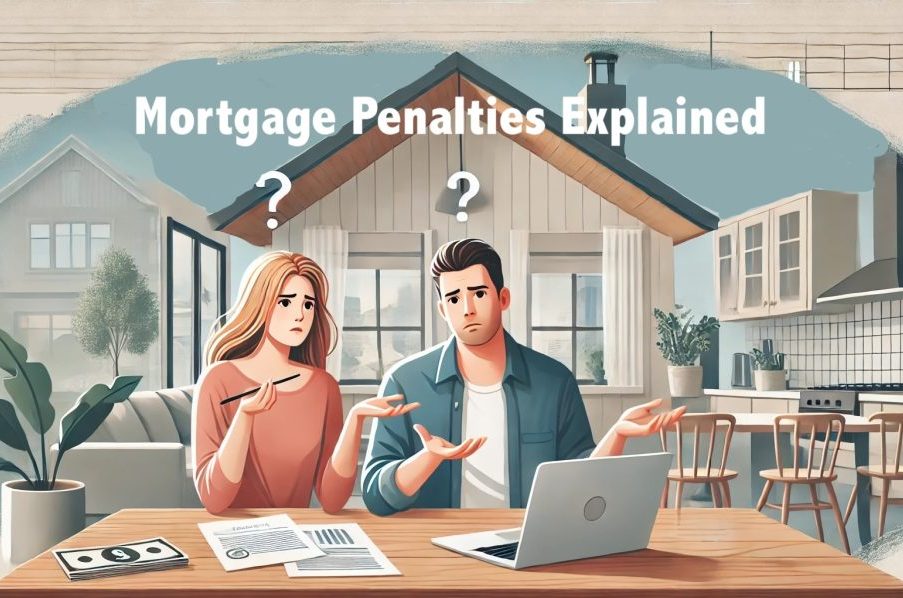When you select your mortgage product, you’re entering into a contractual agreement with the lender for a specific closed term. Should you find yourself needing to return the mortgage early, you’re essentially breaching your contract with the lender. Consequently, the lender will then impose a penalty for breaking it early.
Think of this as the lender’s return policy. If you’re purchasing something that you’re not 100% sure you’ll want to keep, you’ll want to learn about the store’s return policy. When you break your mortgage, you’re essentially returning the borrowed funds to the lender.
How the penalty is calculated can vary significantly from one lender to the next.
Mortgage Penalty vs. Mortgage Savings
Many people believe that the lowest rate mortgage will be the one that saves them the most money over time. However, this may not be true if the lower rate you secured was with a higher penalty lender. One of the biggest opportunities to save money on your mortgage is by choosing a lender with a consumer-friendly formula for calculating your penalty. It’s amazing how many people will tell me that they don’t plan on returning their mortgage early, so they are not concerned about the return penalty being high.
The problem is that circumstances change.
Things come up.
Life throws you curveballs.
Anything can happen in a five-year period. Many don’t plan on returning their mortgage, but people don’t plan on getting divorced either. But it happens. As a result, many borrowers end up returning their mortgages before the end of the term. If they knew they would be in this situation, then they would have chosen a more suitable mortgage product.
Variable Rate Penalties
Variable rate mortgage penalties are generally limited to three months’ interest, regardless of the lender you are dealing with. The formula is straightforward:
Mortgage balance x interest rate ÷ 4
For example, if you have a $400,000 mortgage at 5.00%, formula would look like this:
$400,000 x 0.05 ÷ 4 = $5,000
Most lenders will use the contract rate to calculate the penalty (the rate your payment is based on). However, some use the prime rate, which would result in a higher penalty. It’s best to ask your broker or the bank to confirm which rate your penalty is based on.
It’s important to note that there are some exceptions to the standard three months’ interest penalty. There are a few variable products that come with a substantially higher penalty, typically around 2.75 or 3.00% of the balance. When returning a mortgage at 2.25% with a $300,000 balance, the three months’ interest penalty would be $1,687. At 2.75%, the penalty would be $8,250. Huge difference.
So why would anyone choose a variable rate that comes with such a high return penalty?
Most of the time, these products are at lower rates, which makes them seem more attractive. However, the potential downside is the significant cost involved if the mortgage is returned before the end of the term. While the lower rate promises savings over time, the savings can quickly be outweighed by the hefty penalty for early termination.
To justify going with a variable rate with an excessively high return penalty, I like to see a rate difference of at least 0.15%. There also must be reasonable certainty that the borrower will be content with their home for the full five-year term. Even then, it doesn’t come without strong warning.
An example of this would be a couple who has been married for 25 plus years with a great relationship, kids moved out, and no plans to ever move out of their home.
The opposite would be a couple in their twenties who have been dating for two months and purchasing their first home.
See the difference?
Fixed Rate Penalties
Regardless of which lender you choose, the penalty to return a fixed rate mortgage is typically the greater of three months’ interest or the interest rate differential (IRD). The IRD is the difference between your current rate and the new rate the lender says they can get when they re-lend the money after you have returned it. The IRD compensates the lender for lost profit if their reinvestment rate is lower than your rate when re-lending the money for the remainder of your original term.
The simplest way to explain the concept is if the rate for a similar term to what you have remaining is the same or higher than your current rate at the time you return, then you would pay three months’ interest. If it’s lower, you would pay the interest rate differential… if it’s greater than three months’ interest. That explains the concept, however, the actual calculation is not that simple.
Let me further explain. The lender compares the interest rate on your mortgage with their current rate for a term closest to the time remaining on your term. In other words, if you have a 5-year fixed and you return it after three years, then there are two years remaining. The lender’s 2-year fixed rate is what they use to calculate your penalty, as it matches what you have remaining on your current term. This would be considered the reinvestment rate.
For example, let’s say you have a 5-year fixed at 4.99% and choose to return it after three years. The lender’s current 2-year fixed is 3.99% (reinvestment rate). The two-year rate is used as it’s the closest term to what’s remaining on your current term. This means the lender will be collecting 1.00% less interest when they re-lend the money you are returning. It’s that 1.00% difference that the lender will use to ensure they are compensated due to the lower reinvestment rate.
The further the reinvestment rate drops below your contract rate, the higher your penalty may become.
All lenders use similar wording: The greater of three months’ interest or the interest rate differential. This can lead you to believe that the penalty would be the same with each lender. However, nothing could be further from the truth.
Interest Rate Differential (IRD) Calculation Methods
When it comes to the IRD, all penalties are not created equal. It can be calculated in different ways, with each providing a substantially different figure:
- Based on the contract rate
- Based on receiving a discount off the posted rate
- Reinvestment rate tied to bond yields
1. Based on the Contract Rate
This is the best and most fair way for a lender to calculate the IRD penalty. This is the method used by lenders such as First National, MCAP, MCAN, RFA and most other monoline lenders. These are known as fair penalty lenders.
The reason why they are considered fair penalty lenders is because their reinvestment rates tend to be at market rates or higher. The higher the reinvestment rate, the lower the IRD. This is because the lender can relend or ‘reinvest’ the returned funds at a higher rate of return.
Note that dealing with a fair penalty lender does not mean that your penalty will be low. If the reinvestment rate is significantly lower than your contract rate when you return your mortgage, then you could end up with a high penalty regardless of lender. Just not quite as high as it could be with a harsher penalty lender.
2. Based on Receiving a Discount Off the Posted Rate
This is the method used by all the big banks, as well as some credit unions. They calculate the IRD penalty by applying your original discount off the posted rate to their closest comparable posted rate.
As these lenders give you a “discount” off an inflated posted rate, it drives down their reinvestment rate, which in turn, drives up the IRD. This can result in a substantially inflated penalty. The larger the discount, the lower the reinvestment rate… and the lower the reinvestment rate, the higher the IRD penalty.
3. Reinvestment Rate Tied to Bond Yield
A small number of lenders will use a reinvestment rate that’s tied to bond yields. This is one of the harshest formulas used to calculate the IRD penalty. It can create an extremely low reinvestment rate, resulting in a much larger IRD. Once again, the lower the reinvestment rate, the higher the IRD.
As the reinvestment rates are lower, the lender would then earn a smaller ‘perceived’ return when relending or ‘reinvesting’ the returned funds.
Regardless of the method being used, the penalty will never fall below three months’ interest unless there are fewer than three months remaining on the term.
The penalty to break a fixed rate mortgage with a harsher penalty lender such as a major bank can be as much as 900% higher than most of the non-bank lenders. This could mean the difference between a $5,000 penalty or a $45,000 penalty. Just to be clear, there is not always this big of a difference in penalty. While a 900% higher penalty is possible, it’s not that common. What is common is a penalty that is 300-500% higher. Either way, the difference can be substantial.
Returning Within Three Months of Maturity
If you’re returning your mortgage with less than three months to your maturity date, most lenders will charge a penalty equal to what’s remaining on your current term. For instance, if you have six weeks remaining, they will only charge you the interest for those six weeks. However, there are some lenders who will still charge the full three months’ interest… even if returning your mortgage with one week left in the term.
Conclusion
While it’s great to secure a mortgage with a low interest rate, how the penalty is calculated should always be considered if you think there is even a small chance that you may need to return the funds to the lender early (breaking your mortgage).
Variable rate penalties are simple to understand. However, fixed rate penalties can be a lot more complex. Unfortunately, mortgage lenders do not disclose or explain this clearly in their documentation. In fact, they generally don’t explain it at all. When reading through the fine print, don’t expect to see anything relating to a harsher formula being used to calculate the penalty on a fixed rate mortgage. However, the difference in penalty can be huge from one lender to the next.
The above blog is largely an excerpt from my Amazon #1 best selling book Beat the Bank – How to Win the Mortgage Game in Canada. In the book, I go into more detail, including three ways to lower your penalty, should you find yourself in a position where you’ll be returning your mortgage early. Pick up your copy today!








Leave A Comment